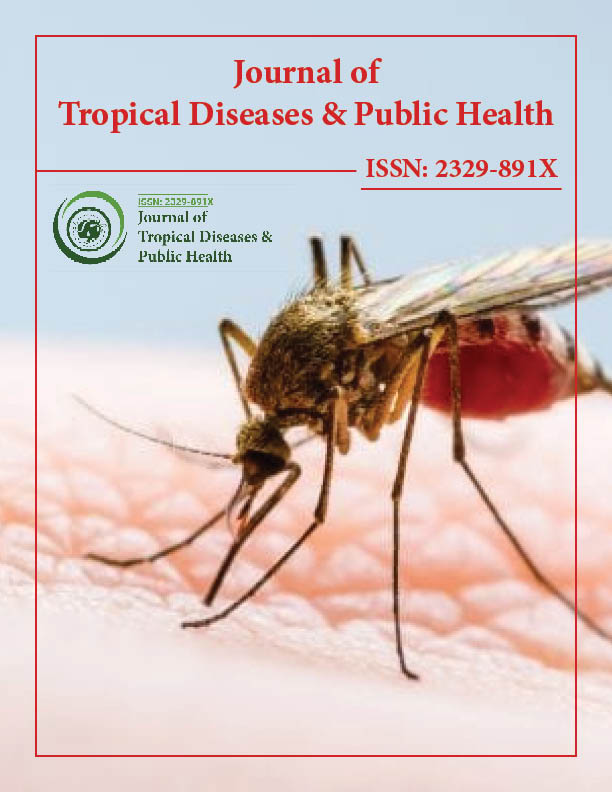Indexed In
- Open J Gate
- Academic Keys
- ResearchBible
- China National Knowledge Infrastructure (CNKI)
- Centre for Agriculture and Biosciences International (CABI)
- RefSeek
- Hamdard University
- EBSCO A-Z
- OCLC- WorldCat
- CABI full text
- Publons
- Geneva Foundation for Medical Education and Research
- Google Scholar
Useful Links
Share This Page
Journal Flyer

Open Access Journals
- Agri and Aquaculture
- Biochemistry
- Bioinformatics & Systems Biology
- Business & Management
- Chemistry
- Clinical Sciences
- Engineering
- Food & Nutrition
- General Science
- Genetics & Molecular Biology
- Immunology & Microbiology
- Medical Sciences
- Neuroscience & Psychology
- Nursing & Health Care
- Pharmaceutical Sciences
Short Communication - (2025) Volume 13, Issue 1
Epidemiological and Environmental Determinants of Dengue Transmission
Takano Yuchen*Received: 24-Feb-2025, Manuscript No. JTD-25-29245; Editor assigned: 26-Feb-2025, Pre QC No. JTD-25-29245; Reviewed: 12-Mar-2025, QC No. JTD-25-29245; Revised: 19-Mar-2025, Manuscript No. JTD-25-29245; Published: 26-Mar-2025, DOI: 10.35241/2329-891X.25.13.463
Description
Dengue is a mosquito-borne viral infection that poses a significant public health challenge, particularly in tropical and subtropical regions around the world. The primary vector responsible for transmitting dengue is the Aedes aegypti mosquito, although Aedes albopictus can also serve as a vector in some regions. These mosquitoes are well adapted to urban environments and typically breed in stagnant water found in containers, discarded tires, flower pots, and other man-made habitats. They are day-biting mosquitoes, with peak feeding times in the early morning and late afternoon.
In some cases, the disease progresses to a more severe form known as severe dengue or dengue hemorrhagic fever. This condition can lead to plasma leakage, fluid accumulation, severe bleeding, and organ impairment. If not properly managed, it may result in dengue shock syndrome, a potentially fatal complication. Severe dengue is more likely to occur in individuals who have had a previous dengue infection with a different serotype, due to a phenomenon known as Antibody Dependent Enhancement (ADE), where preexisting antibodies from the first infection enhance the severity of the second infection.
Diagnosis of dengue is based on clinical symptoms and is confirmed through laboratory tests, such as detection of viral the presence of dengue specific antigens or antibodies in the blood. Early diagnosis and appropriate medical care are critical in reducing mortality rates, especially for severe cases [1-5].
There is no specific antiviral treatment for dengue. Management primarily involves supportive care, including maintaining proper hydration, managing pain and fever with acetaminophen not aspirin or ibuprofen, as they can increase bleeding risk and close monitoring for warning signs of severe disease. Hospitalization may be necessary for patients with severe symptoms or those at risk of complications.
Preventing dengue largely depends on controlling mosquito populations and minimizing human exposure to mosquito bites. Vector control strategies include eliminating standing water in and around homes, covering water storage containers, using insecticides, and deploying mosquito traps. Personal protective measures, such as wearing long-sleeved clothing, using mosquito repellents, and sleeping under bed nets, are also important, especially during outbreaks. However, its use is recommended only for individuals who have had a prior dengue infection, as vaccination in seronegative individuals has been associated with an increased risk of severe dengue upon subsequent infection. Research is ongoing into the development of new vaccines that are safer and effective for broader populations [6-10].
Dengue continues to spread globally, with an estimated 100–400 million infections occurring annually, according to the World Health Organization (WHO). Climate change, urbanization, increased international travel, and inadequate public health infrastructure contribute to the expanding geographic range and intensity of dengue outbreaks. In recent years, dengue has been reported in areas that were previously unaffected, including parts of Europe and the southern United States.
Conclusion
Dengue is a significant and growing global health threat with complex challenges related to its transmission, diagnosis, treatment, and prevention. While no cure currently exists, effective management and prevention strategies centered on vector control, public health preparedness, vaccination, and community participation can significantly reduce the disease burden. As climate and demographic trends continue to evolve, addressing dengue will require adaptive, multidisciplinary approaches to protect vulnerable populations and reduce the impact of future outbreaks.
References
- Yang L, Liu S, Liu J. COVID-19: immunopathogenesis and Immunotherapeutics. Signal Transduct Target Ther. 2020; 5(1):128.
[Crossref] [Google Scholar] [PubMed]
- Yuki K, Fujiogi M, Koutsogiannaki S. COVID-19 pathophysiology: A review. Clin Immunol. 2020; 215:108427.
[Crossref] [Google Scholar] [PubMed]
- Harper L, Kalfa N, Beckers GM, Kaefer M. The impact of COVID-19 on research. J Pediatr Urol. 2020; 16(5):715-716.
[Crossref] [Google Scholar] [PubMed]
- Mathieu E, Ritchie H. A global database of COVID-19 vaccinations. Nat Hum Behav. 2021; 5(7):947-953.
[Crossref] [Google Scholar] [PubMed]
- Cullen W, Gulati G, Kelly BD. Mental health in the COVID-19 pandemic. QJM. 2020; 113(5):311-312.
[Crossref] [Google Scholar] [PubMed]
- Padhan R, Prabheesh KP. The economics of COVID-19 pandemic: A survey. Econ Anal Policy. 2021; 70:220-237.
[Crossref] [Google Scholar] [PubMed]
- Li T, Lu H, Zhang W. Clinical observation and management of COVID-19 patients. Emerg Microbes Infect. 2020;9(1):687-690.
[Crossref] [Google Scholar] [PubMed]
- Guner HR, AktaÅ? F. COVID-19: Prevention and control measures in community. Turk J Med Sci. 2020;50(9):571-577.
[Crossref] [Google Scholar] [PubMed]
- Stopsack KH, Mucci LA, Antonarakis ES, Nelson PS, Kantoff PW. TMPRSS2 and COVID-19: Serendipity or Opportunity for Intervention?. Cancer Discov. 2020;10(6):779-782.
[Crossref] [Google Scholar] [PubMed]
- Shereen MA, Khan S, Kazmi A, Bashir N, Siddique R. COVID-19 infection: Emergence, transmission, and characteristics of human coronaviruses. J Adv Res. 2020;24:91-98.
[Crossref] [Google Scholar] [PubMed]
Citation: Yuchen T (2025). Epidemiological and Environmental Determinants of Dengue Transmission. J Trop Dis. 13:463
Copyright: © 2025 Yuchen T. This is an open-access article distributed under the terms of the Creative Commons Attribution License, which permits unrestricted use, distribution and reproduction in any medium, provided the original author and source are credited

